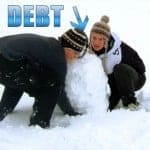I‘ve been reading a lot lately about how one method or the other is best for getting out of debt.
There are a ton of programs being touted as “the best”, and I do think some probably work better than others. So what do I think is the best?
Quick Navigation
Which Debt Reduction Method is the Best?
Here’s a quick look at a couple of the good ones I’ve seen.

The Debt Snowball
The debt snowball method, taught by Dave Ramsey, is one of the more popular debt reduction tactics being used right now. To do the debt snowball, you follow this progression:
- Put all your debts in order from the smallest balance to the largest.
- Pay the minimum on all of your debts.
- Put any extra money towards paying off the smallest debt first.
- Once the smallest debt is paid off you roll that money over towards paying off the next largest debt.
- Wash, rinse, repeat.
The method is touted as being successful because it gives you some “quick wins” and motivates you to keep paying down your debt. To hear why Dave Ramsey thinks the plan is successful, listen to the audio on this post.
This method is criticized because it isn’t mathematically the soundest way to pay off debt. You will probably end up paying a bit more using this plan than some others. Proponents counter this by saying that the psychological boost you get from this method easily outweighs the small amount of interest you might save.
The Debt Avalanche
Another popular debt reduction method is the debt avalanche as popularized by Consumerism Commentary. Using the debt avalanche works like this:
- Order your debts in order from the highest interest to the lowest interest.
- Pay the minimums on all the debts.
- Put any extra money towards paying off your highest-interest debt.
- Once the highest-interest debt is paid off you roll that money over to paying off the next highest-interest debt.
- Wash, rinse, repeat.
This method is touted as being the mathematically best way to get out of debt. You’ll pay the least amount of interest, and be able to start saving for your future in no time.
This method is criticized because critics believe it doesn’t take into account the human element of debt reduction. It requires you to be more disciplined and be able to follow through with payments even when you don’t see immediate results.
So Which Is Best?
So which method do I think is best for getting out of debt? Whichever one you choose to do! I think personal finance is personal so one person might connect more with one plan and another with the other. More analytical types might work better with the debt avalanche, and more emotionally free spirits may connect better with the debt snowball.
I think as long as you’re making a plan to get out of debt, you are headed down the right path. As Dave Ramsey says:
You can’t go wrong getting out of debt!
You can’t go wrong getting out of debt, no matter what plan you choose. The key is to GET OUT OF DEBT!
Other Debt Snowball Opinions From Around The Web
- Dave Ramsey is bad at math
- In praise of the debt snowball
- The emotional snowball
- The debt snowball and how I made it work for me
- Debt Avalanche. Correct?
- An illustrated guide to debt reduction
Do you think there is a best way to get out of debt? What method have you used to reduce or get rid of debt?




My daughter wrote a blog essay called “Why I won’t save an emergency fund” that got a lot of people hot and bothered. Her point, which some folks seemed to miss entirely, is that it’s better to pay down debt at interest rates upwards of 22 percent than it is to have $1,000 sitting in the bank at 1 to 3 percent. She also did some math to show that even if an emergency DID happen, it generally won’t make that much difference whether you have to put it on a card vs. using the money from the bank account.
I’m with her: Get rid of the debt before you do anything else. You’ll sleep better.
Her article can be found at http://ipickuppennies.blogspot.com/2008/08/why-i-wont-save-emergency-fund.html.
Donna Freedmans last blog post..Family matters more than finance
You’re absolutely right, what works for you is what you need to do. Just do SOMETHING!
Here’s what I don’t get…the debt avalanche is still a snowball. There’s just a different factor that determines the order of repayment. And what about snowflaking–making lots of tiny payments whenever you save a bit of money.
And why all the snow metaphors anyways. How about having a debt inferno or debt A-Bomb?
Thanks for the link!
We’ve been using a Frankenstein version of these where we really look into it and pick the next debt based on many more factors besides just rate and balance. When it comes down to it, whatever works for you is what you should do.
Beating Brokes last blog post..Quicken 2009 Available, Get 25% Off
Thanks for this. Dave Ramsay hasn’t made much of a dent here in the UK, but I’m always reading about him on US-based PF blogs – it’s really useful to have his strategy explained in such a clear, concise way.
I go with the Avalanche model: clearing our largest, highest-interest debt has taken a while, but has also taken a HUGE weight off our shoulders now that it is gone. And we did see the benefits quickly mount, as month after month the estimated next month’s interest charges went down and down. Yippee!
Well thanks for the shilling, mom. I do always appreciate it.
While I do stand behind my method in most cases, I do also say that in the end you have to go with what works for you, not what the numbers say. Because as long as you are happy with your progress, you’re more likely to keep it up. My article just points out that people often rationalize that having an EF is safer financially and makes more sense. That’s really not true, in most cases.
Abbys last blog post..We are not amused
I totally agree that the method you actually use to payoff your debt is what is best for you. Ramsey has said many times in the past couple of weeks, “My math is wrong, but I’m still right”.
I don’t see why this is such a “religious issue”, other than Dave’s own strong personal opinion about it. People who criticize the debt snowball will show an example of $10k at high interest and $1k at low interest. That’s not common for someone in debt trouble. I have about 12 debts right now and tracking each one is getting old (I’m just starting step 2). The psychological benefit of getting about half of these pests out of my life (the small ones) is very real.
Also, whether you snowball or avalanche, the whole process usually lasts between 6-24 months. The difference in interest in that time frame is very little in comparison with:
1. the amount of interest that someone in debt trouble has already paid in “stupid tax”.
2. The overall debt paid off over that time frame.
Having said that, I have already decided to “snowball” for 4-6 months to kill the small ones, and then shift to an avalanche to quickly get rid of some ridiculous interest payments I am swimming in. Getting rid of the little ones first though, really helps me focus on the big ones. Notice, that once my picture looks a lot like the situation used to criticize the snowball, I ditch the snowball?
You don’t have to listen to Ramsey to get out of debt and build wealth, but I don’t know of anyone who’s followed his larger advice on the matter and regretted it, either. That’s huge.
I just read a book by Liz Pulliam Weston that had an additional theory for debt repayment.
If you are trying to repair your credit in addition to paying down your debt, she advised paying down the card that was closest to the limit first. Then, once you got that down, I would assume you would go on to pay the highest interest cards next.
This was interesting to me because it really would raise your credit – by lowering your debt to credit ratio almost immediately. However, you would end up paying more in interest, so maybe it’s not the most financially sound thing to do.
Probably cheaper than paying high interest on “bad credit” credit cards though!
Out of the three approaches mentioned in this post and comments:
1. debt snowball
2. debt avalance
3. paying off credit card closes to the limit
…some may be more financially correct than others, but it’s helpful to know the pros and cons of each approach and how they gel with an individual’s personality.
Jenna’s approach may win depending on a few factors. The person with a load of debt and long payback is the target for her advice. Improve your FICO and you are likely to receive offers to transfer some debt at zero interest. Careful use of these offers can help your payoff accellerate.
JoeTaxpayers last blog post..Free eBook “Money Matters For All Ages”
Since I like to feel like I am making progress, I like paying off the lowest balance first. It’s what we did. It can really, really help you feel like you are doing a good job. Sounds like drivel, I know, but for me and my husband, being able to celebrate a little after each credit card was paid off really helped us get excited for the next one.
Mirandas last blog post..Friday Fun Video: Election 2008 from JibJab
Personally, I liked using the snowball approach as I like to see progress quickly. It will probably save you some money if you use the avalanche approach, but it might not work for everyone. For some, it might seem like a long time to get out of debt and they can become frustrated.
I concur, whatever works for an individual is the best method to use. Personally I enjoy the concept Dave Ramsey teaches because it has that psychological effect on people to continue doing it. On the other hand when you are avalanching your debt you could easily be discouraged.
Our Debtologists at DebtMakeover recommend the TYPHOON Program, it is a system where your FIRST STEP is to transfer all your Credit Cards into NO Interest rate, start paying the minimum on ALL Credit Cards (since cards are at 0 %, all your money is going towards paying off the principle) STEP TWO….Pay extra on your Lowest balance credit card to get you motivated and once this card is fully paid, goto STEP THREE…Then you start paying off your HIGHEST interest cards first NO matter what the balance is, by doing this more of the monthly payment eventually goes to principle and less to interest…TYPHOON Program really works.
I agree the point is to eliminate debt and whatever is going to get you to do it and finish,just DO IT!
The thing I like about the snowball is that it is geared towards changing and undoing behaviors that got you into the mess in the first place. I have sen numerous people get bogged down on their largest interest debt because they don’t get to change their behavior and perspective before they tackle the biggest mountain.
I think it is also important to know that we are often only talking a little bit of money between most snowball and avalanche systems.
The Happy Rocks last blog post..The Ingredient Experiment – Save Money And Eat Better
Two interesting ways two pay off your debt i think the debt snowball would boost your confidence quicker seeing a difference . but would make more sense to pay off it higher interest rate first in avalanche, great post
All you have to do is aggregate your total revolving debt and feel good as the total balance goes down each month, which will happen the fastest by attacking the highest interest rate first! I am doing this and it feels great! I would only snowball if the smaller balance can be paid off in a month or two, otherwise, very dumb.
Thanks for sharing these ideas. My wife and I are using the debt snowball to help us pay down our debts. Feel free to follow our journey at passingthroughdebt.blogspot.com.
This is the first that I’ve heard of the debt avalanche sounds interesting. Although I have to agree with the other posters. It does sound like the snowball except applied to a higher bill. For us, the psychological boost of the snowball has us pumped up and ready for more. Not sure we’d feel that way if we tried the avalanche approach. It’s a good concept though. I’ll have to ponder it.
I had a question about both of these methods… Let’s say I have 5 debts and I start saving to pay one off completely- to make things easier, let’s assume the first debt is $10,000- while making minimum payments. If I save an extra $200/month, for example, do I put that $200 towards that debt right away or do you wait 5 months until you have $10,000 and pay it all as a lump sum?
I am currently under the impression that you pay minimum payments on everything until you save up and pay off one debt… and continue to do that one at a time.
Typically in both methods I think you would put the extra $200/month you have towards the debt right away (whether it’s smallest or highest interest debt – depending on the method).
So if doing the debt snowball for example, in month one you if you have 4 debts of $1000 and 1 debt of $500. If each has a $50 minimum payment, you’d pay:
Debt 5: $50
Debt 4: $50
Debt 3: $50
Debt 2: $50
Debt 1: $250 ($50 plus $200 extra towards smallest debt)
By paying the extra right away, you’ll end up paying less interest since the balance is lower.
Good luck!